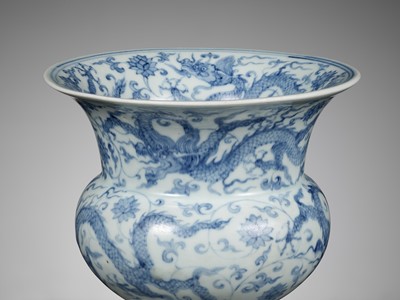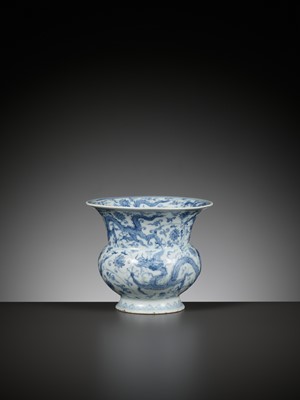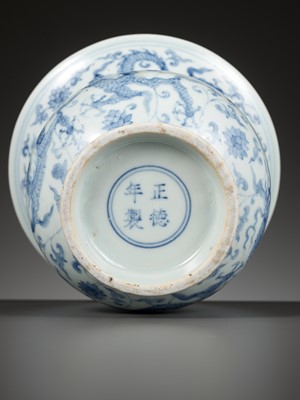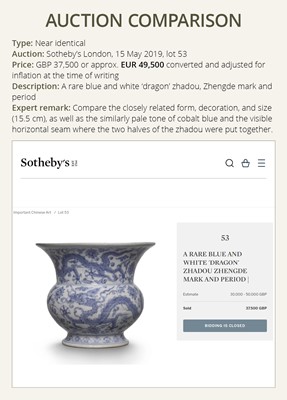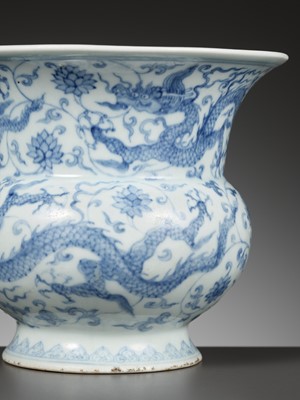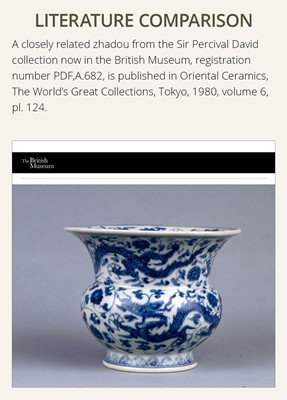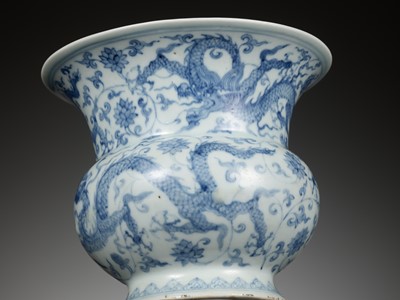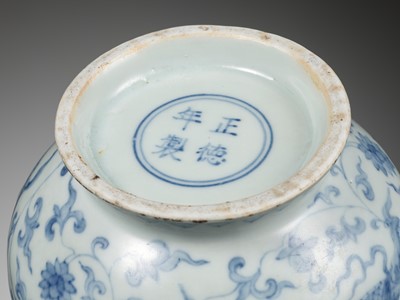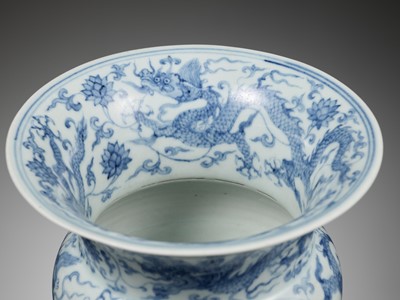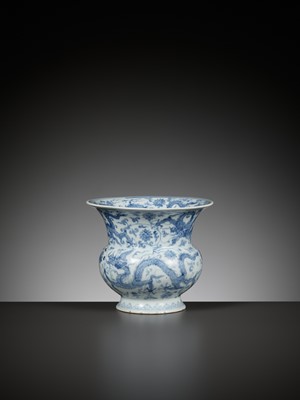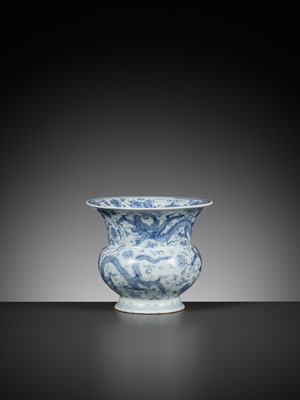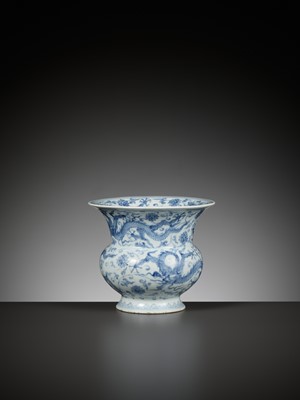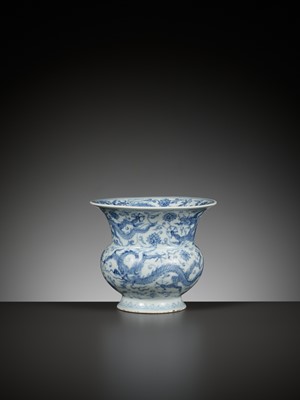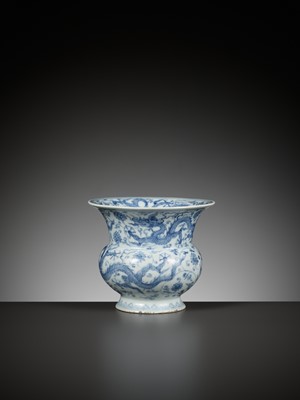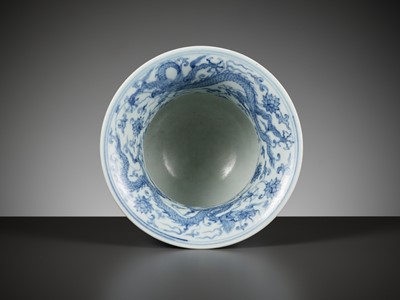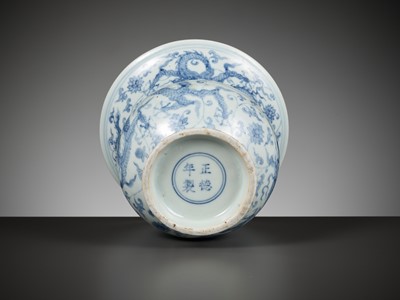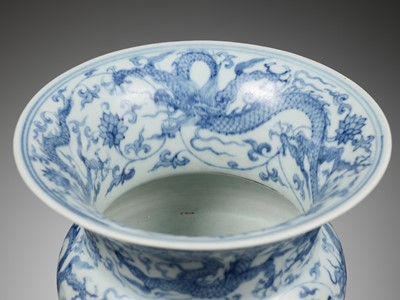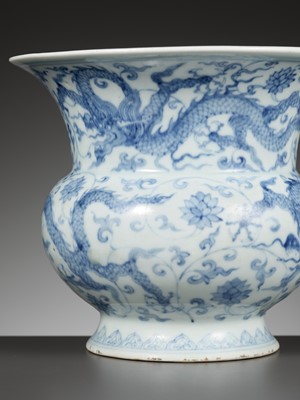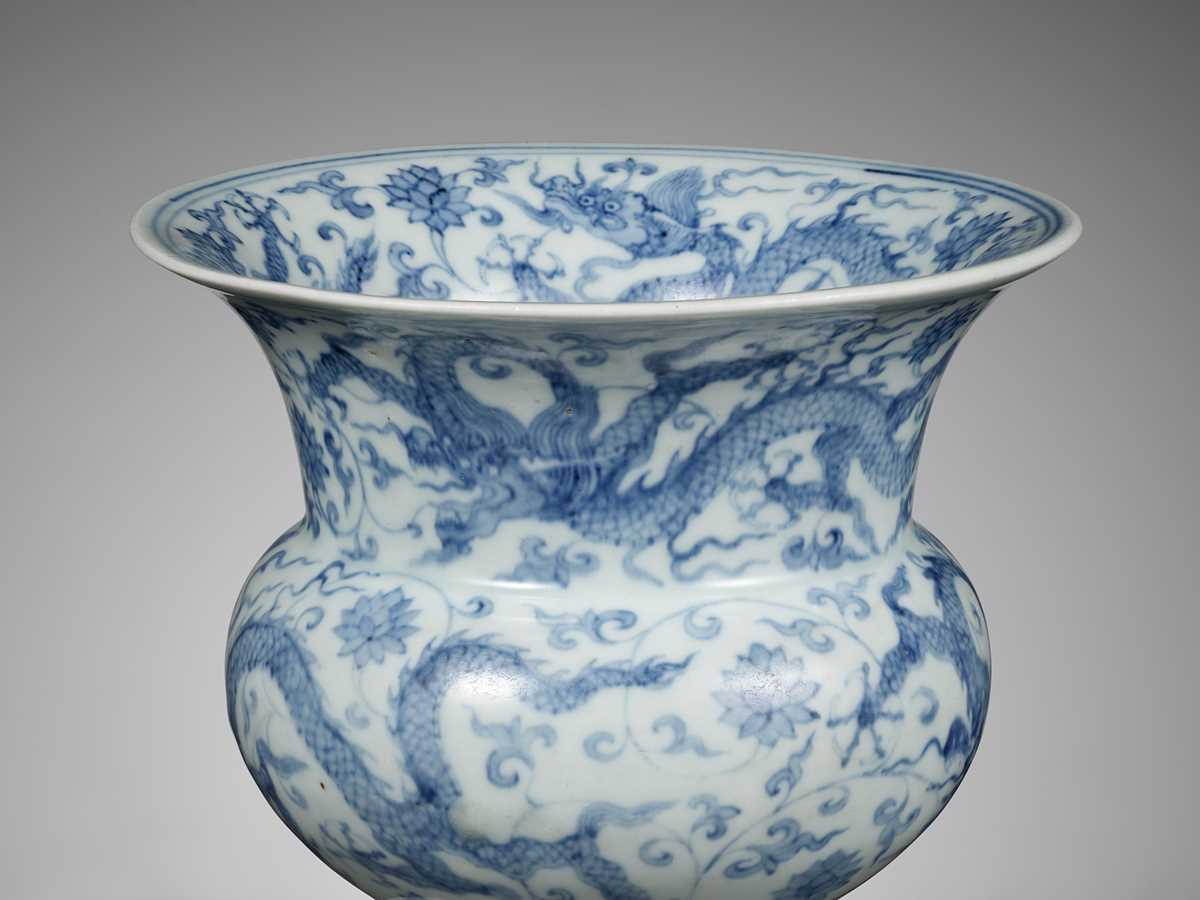10th Mar, 2023 10:00
TWO-DAY AUCTION - Fine Chinese Art / 中國藝術集珍 / Buddhism & Hinduism
374
A RARE BLUE AND WHITE 'DRAGON' ZHADOU, ZHENGDE MARK AND PERIOD
正德款及年代青花穿蓮龍紋渣斗
Sold for €7,800
including Buyer's Premium
China, 1506-1521. The compressed globular body rising from a short spreading foot to a broad flaring neck, painted around the exterior with two bands of scaly five-clawed dragons amidst scrolling leafy lotus, the interior of the neck similarly painted, all above a ruyi band at the foot. The recessed base with an underglaze-blue four-character mark Zhengde nianzhi and of the period.
Provenance: Chamberlain Antiques, Amherst, New Hampshire, USA, 2010. An Irish private collection, acquired from the above.
Condition: Good condition with old wear, traces of use and shallow surface scratches. Distinctive firing irregularities, including the horizontal seam where the two halves of the zhadou were put together being visible to both the interior and exterior, with several smoothened glaze blisters along the seam to the exterior. The seam between the neck and the vessel has an associated glaze recess on the interior. Minor kiln grit. The foot somewhat smoothened. The edges of the foot burnt to orange in the firing.
Weight: 652.2 g
Dimensions: Diameter 15.4 cm, Height 12.8 cm
The present jar is notable for its delicate yet lively painting of dragons amid a luscious floral scroll, a motif that originated in the early Ming dynasty and was particularly favored at the Zhengde court. The writhing movement of the creature, which captures its auspicious and positive essence, the unctuous glaze, and the well-proportioned body of the vessel are all characteristic of the period.
The Zhengde reign marks a transition from the refined porcelain vessels of the preceding Chenghua reign to the bold designs of the Jiajing period. Stylistic changes resulted from the political and social instability created by the excessive power and increasing number of corrupt eunuchs at court. While the Zhengde Emperor was encouraged to live a life of luxury and extravagance away from official duties, eunuchs took control of court administration. This had a profound effect on porcelain production at the Imperial kilns in Jingdezhen: the standard of quality for Imperial porcelain remained exceptionally high and the variety of forms and designs increased, however, production shrank as testified by the small amount of excavated material.
The subtle hue of the cobalt blue of these wares as seen on this jar is also noticeably different from the preceding and succeeding reigns, as the material most probably came from local mines. The Ruizhou fuzhi (Annals of Ruizhou prefecture) from 1515 mentions that ‘At Tianzi Hill in Shanggao County [Jiangxi province] there is a nameless stone which is used at Jingdezhen as a painting medium on porcelain’, which suggests that Jiangxi was one source of cobalt pigment (Wang Qingzheng, Qinghua youlihong / Underglaze Blue and Red, Hong Kong, 1987, p. 11).
Both the form and decoration of this jar follow early Ming prototypes. The globular shape with its wide everted rim originated from archaic bronze zun, but was made in porcelain from the early 15th century. Over the centuries the rim evolved to become wider and the body more compact. Although jars of this form are often referred to as ‘spittoons’, they were probably used as general waste jars at tables. A Yuan scholar observed that ‘During Song times, when prominent families held banquets, jinping [receptacle for chopsticks] and zhadou [spittoon] would certainly be placed on the tables’ (see The Radiant Ming 1368-1644 through the Min Chiu Society Collection, Hong Kong Museum of History, Hong Kong, 2015-2016, p. 37).
Literature comparison:
Three closely related zhadou in the Palace Museum, Beijing, were included in the Museum’s exhibition ‘Imperial Porcelains from the Reign of Hongzhi and Zhengde in the Ming Dynasty’, Beijing, 2017, volume 2, cat. nos. 180-182, together with a reconstructed example excavated at the Imperial kiln site in Zhushan, cat. no. 418. One in the National Palace Museum, Taipei, was included in Radiating Hues of Blue and White, Taipei, 2016, pl. 76. Another from the Sir Percival David collection now in the British Museum, registration number PDF,A.682, is published in Oriental Ceramics, The World’s Great Collections, Tokyo, 1980, volume 6, pl. 124, and a further example from the Lauritzen collection in the Museum of Far Eastern Antiquities, Stockholm, is illustrated ibidem, volume 8, pl. 228.
Auction result comparison:
Type: Near identical
Auction: Sotheby’s London, 15 May 2019, lot 53
Price: GBP 37,500 or approx. EUR 49,500 converted and adjusted for inflation at the time of writing
Description: A rare blue and white ‘dragon’ zhadou, Zhengde mark and period
Expert remark: Compare the closely related form, decoration, and size (15.5 cm), as well as the similarly pale tone of cobalt blue and the visible horizontal seam where the two halves of the zhadou were put together.
正德款及年代青花穿蓮龍紋渣斗
中國 ,1506-1521年。渣斗喇叭口,寬頸,圓腹,圈足外撇。外壁及口沿內側以青花龍紋為飾,隙地滿繪纏枝番蓮紋,圈足外繪如意雲紋一圈,口沿內外緣及圈足下緣各有兩道弦紋邊飾。圈足底緣露胎呈白色,圈足内中央以青花書“正德年製” 雙圈四字雙行楷款。
來源:美國新罕布什爾州阿默斯特Chamberlain Antiques藝廊,2010年;愛爾蘭私人收藏,購於上述藝廊。
品相:狀況良好,有磨損、使用痕跡和表面淺劃痕,明顯的燒製不規則性,包括在內外可見的渣斗兩半拼合處的水平接縫,沿接縫到外部有數處釉面氣泡。頸部和容器之間的接縫在內部有一個釉槽;小窯砂,足部邊緣成橙色。
重量:652.2 克
尺寸:直徑 15.4 厘米,高12.8 厘米
穿蓮龍紋起源於明初,尤其受到正德宮廷的青睞,龍飛騰時其吉祥和積極的本質,光滑的釉質,以及勻稱的器身都是這一時期的特徵。
正德瓷器由成化前的細膩瓷器過渡到嘉靖時期的大膽設計。這種變化是由於太監權力過大和朝廷腐敗引起的政治和社會不穩定造成。正德皇帝不務國務,過著奢侈的生活,太監控制了朝廷。這對景德鎮御窯的瓷器生產產生了深遠的影響:宮廷瓷器的質量標準仍然非常高,形式和設計的多樣性有所增加,但出土量很少,證明了產量的下降。
從這個渣斗上可以看出,青花發色也與前後王朝明顯不同,因為材料很可能來自當地。1515年《瑞州府志》記載“上高縣天則崗有無名子,景德鎮用以繪畫瓷器”,可見江西是鈷料瓷器的發源地之一,見汪慶正《青花釉裏紅》,香港,1987年,第11頁。
此器無論是形制還是紋飾都沿用了明初的原型。敞口外翻和圓腹起源於青銅尊,但從十五世紀初開始用陶瓷製成。幾個世紀以來,口部逐漸變得更寬,身體更緊湊。這個形制的唾壺,是歷史悠久的中國傳統工藝品,起源於晉代,用於盛裝唾吐物。如置於餐桌,專用於盛載肉骨魚刺等食物渣滓,小型者亦用於盛載茶渣,故也列於茶具之中。元人筆記載“宋季大族設席,几案間必用筋瓶、渣斗”,即指此物。
文獻比較:
Three比較三件非常相近的渣斗,一件北京故宮博物院館藏,展覽於《Imperial Porcelains from the Reign of Hongzhi and Zhengde in the Ming Dynasty》,北京,2017年,卷2,圖錄編號180-182,附景德鎮御窯遺址出土復原件,圖錄編號418。一件臺北故宮博物院《Radiating Hues of Blue and White》,臺北,2016年,圖76。另一件來自 Sir Percival David collection,現藏於大英博物館,館藏 編號 PDF,A.682,出版於東方陶瓷學會,《The World’s Great Collections》,東京,1980年,卷6,圖124;另一件來自Lauritzen collection,現藏於斯德哥爾摩遠東博物館,件上述書,卷8,圖228。
拍賣結果比較:
形制:幾乎相同
拍賣:倫敦蘇富比,2019年5月15日,lot 53
價格:GBP 37,500(相當於今日EUR 49,500)
描述:明正德青花穿花龍紋渣斗《正德年製》款
專家評論:比較非常相近的外形,裝飾和尺寸 (15.5 厘米),以及同樣淡藍色調和可見的兩半拼合處的水平接縫。
#byimperialcommand
China, 1506-1521. The compressed globular body rising from a short spreading foot to a broad flaring neck, painted around the exterior with two bands of scaly five-clawed dragons amidst scrolling leafy lotus, the interior of the neck similarly painted, all above a ruyi band at the foot. The recessed base with an underglaze-blue four-character mark Zhengde nianzhi and of the period.
Provenance: Chamberlain Antiques, Amherst, New Hampshire, USA, 2010. An Irish private collection, acquired from the above.
Condition: Good condition with old wear, traces of use and shallow surface scratches. Distinctive firing irregularities, including the horizontal seam where the two halves of the zhadou were put together being visible to both the interior and exterior, with several smoothened glaze blisters along the seam to the exterior. The seam between the neck and the vessel has an associated glaze recess on the interior. Minor kiln grit. The foot somewhat smoothened. The edges of the foot burnt to orange in the firing.
Weight: 652.2 g
Dimensions: Diameter 15.4 cm, Height 12.8 cm
The present jar is notable for its delicate yet lively painting of dragons amid a luscious floral scroll, a motif that originated in the early Ming dynasty and was particularly favored at the Zhengde court. The writhing movement of the creature, which captures its auspicious and positive essence, the unctuous glaze, and the well-proportioned body of the vessel are all characteristic of the period.
The Zhengde reign marks a transition from the refined porcelain vessels of the preceding Chenghua reign to the bold designs of the Jiajing period. Stylistic changes resulted from the political and social instability created by the excessive power and increasing number of corrupt eunuchs at court. While the Zhengde Emperor was encouraged to live a life of luxury and extravagance away from official duties, eunuchs took control of court administration. This had a profound effect on porcelain production at the Imperial kilns in Jingdezhen: the standard of quality for Imperial porcelain remained exceptionally high and the variety of forms and designs increased, however, production shrank as testified by the small amount of excavated material.
The subtle hue of the cobalt blue of these wares as seen on this jar is also noticeably different from the preceding and succeeding reigns, as the material most probably came from local mines. The Ruizhou fuzhi (Annals of Ruizhou prefecture) from 1515 mentions that ‘At Tianzi Hill in Shanggao County [Jiangxi province] there is a nameless stone which is used at Jingdezhen as a painting medium on porcelain’, which suggests that Jiangxi was one source of cobalt pigment (Wang Qingzheng, Qinghua youlihong / Underglaze Blue and Red, Hong Kong, 1987, p. 11).
Both the form and decoration of this jar follow early Ming prototypes. The globular shape with its wide everted rim originated from archaic bronze zun, but was made in porcelain from the early 15th century. Over the centuries the rim evolved to become wider and the body more compact. Although jars of this form are often referred to as ‘spittoons’, they were probably used as general waste jars at tables. A Yuan scholar observed that ‘During Song times, when prominent families held banquets, jinping [receptacle for chopsticks] and zhadou [spittoon] would certainly be placed on the tables’ (see The Radiant Ming 1368-1644 through the Min Chiu Society Collection, Hong Kong Museum of History, Hong Kong, 2015-2016, p. 37).
Literature comparison:
Three closely related zhadou in the Palace Museum, Beijing, were included in the Museum’s exhibition ‘Imperial Porcelains from the Reign of Hongzhi and Zhengde in the Ming Dynasty’, Beijing, 2017, volume 2, cat. nos. 180-182, together with a reconstructed example excavated at the Imperial kiln site in Zhushan, cat. no. 418. One in the National Palace Museum, Taipei, was included in Radiating Hues of Blue and White, Taipei, 2016, pl. 76. Another from the Sir Percival David collection now in the British Museum, registration number PDF,A.682, is published in Oriental Ceramics, The World’s Great Collections, Tokyo, 1980, volume 6, pl. 124, and a further example from the Lauritzen collection in the Museum of Far Eastern Antiquities, Stockholm, is illustrated ibidem, volume 8, pl. 228.
Auction result comparison:
Type: Near identical
Auction: Sotheby’s London, 15 May 2019, lot 53
Price: GBP 37,500 or approx. EUR 49,500 converted and adjusted for inflation at the time of writing
Description: A rare blue and white ‘dragon’ zhadou, Zhengde mark and period
Expert remark: Compare the closely related form, decoration, and size (15.5 cm), as well as the similarly pale tone of cobalt blue and the visible horizontal seam where the two halves of the zhadou were put together.
正德款及年代青花穿蓮龍紋渣斗
中國 ,1506-1521年。渣斗喇叭口,寬頸,圓腹,圈足外撇。外壁及口沿內側以青花龍紋為飾,隙地滿繪纏枝番蓮紋,圈足外繪如意雲紋一圈,口沿內外緣及圈足下緣各有兩道弦紋邊飾。圈足底緣露胎呈白色,圈足内中央以青花書“正德年製” 雙圈四字雙行楷款。
來源:美國新罕布什爾州阿默斯特Chamberlain Antiques藝廊,2010年;愛爾蘭私人收藏,購於上述藝廊。
品相:狀況良好,有磨損、使用痕跡和表面淺劃痕,明顯的燒製不規則性,包括在內外可見的渣斗兩半拼合處的水平接縫,沿接縫到外部有數處釉面氣泡。頸部和容器之間的接縫在內部有一個釉槽;小窯砂,足部邊緣成橙色。
重量:652.2 克
尺寸:直徑 15.4 厘米,高12.8 厘米
穿蓮龍紋起源於明初,尤其受到正德宮廷的青睞,龍飛騰時其吉祥和積極的本質,光滑的釉質,以及勻稱的器身都是這一時期的特徵。
正德瓷器由成化前的細膩瓷器過渡到嘉靖時期的大膽設計。這種變化是由於太監權力過大和朝廷腐敗引起的政治和社會不穩定造成。正德皇帝不務國務,過著奢侈的生活,太監控制了朝廷。這對景德鎮御窯的瓷器生產產生了深遠的影響:宮廷瓷器的質量標準仍然非常高,形式和設計的多樣性有所增加,但出土量很少,證明了產量的下降。
從這個渣斗上可以看出,青花發色也與前後王朝明顯不同,因為材料很可能來自當地。1515年《瑞州府志》記載“上高縣天則崗有無名子,景德鎮用以繪畫瓷器”,可見江西是鈷料瓷器的發源地之一,見汪慶正《青花釉裏紅》,香港,1987年,第11頁。
此器無論是形制還是紋飾都沿用了明初的原型。敞口外翻和圓腹起源於青銅尊,但從十五世紀初開始用陶瓷製成。幾個世紀以來,口部逐漸變得更寬,身體更緊湊。這個形制的唾壺,是歷史悠久的中國傳統工藝品,起源於晉代,用於盛裝唾吐物。如置於餐桌,專用於盛載肉骨魚刺等食物渣滓,小型者亦用於盛載茶渣,故也列於茶具之中。元人筆記載“宋季大族設席,几案間必用筋瓶、渣斗”,即指此物。
文獻比較:
Three比較三件非常相近的渣斗,一件北京故宮博物院館藏,展覽於《Imperial Porcelains from the Reign of Hongzhi and Zhengde in the Ming Dynasty》,北京,2017年,卷2,圖錄編號180-182,附景德鎮御窯遺址出土復原件,圖錄編號418。一件臺北故宮博物院《Radiating Hues of Blue and White》,臺北,2016年,圖76。另一件來自 Sir Percival David collection,現藏於大英博物館,館藏 編號 PDF,A.682,出版於東方陶瓷學會,《The World’s Great Collections》,東京,1980年,卷6,圖124;另一件來自Lauritzen collection,現藏於斯德哥爾摩遠東博物館,件上述書,卷8,圖228。
拍賣結果比較:
形制:幾乎相同
拍賣:倫敦蘇富比,2019年5月15日,lot 53
價格:GBP 37,500(相當於今日EUR 49,500)
描述:明正德青花穿花龍紋渣斗《正德年製》款
專家評論:比較非常相近的外形,裝飾和尺寸 (15.5 厘米),以及同樣淡藍色調和可見的兩半拼合處的水平接縫。
#byimperialcommand
Zacke Live Online Bidding
Our online bidding platform makes it easier than ever to bid in our auctions! When you bid through our website, you can take advantage of our premium buyer's terms without incurring any additional online bidding surcharges.
To bid live online, you'll need to create an online account. Once your account is created and your identity is verified, you can register to bid in an auction up to 12 hours before the auction begins.
Intended Spend and Bid Limits
When you register to bid in an online auction, you will need to share your intended maximum spending budget for the auction. We will then review your intended spend and set a bid limit for you. Once you have pre-registered for a live online auction, you can see your intended spend and bid limit by going to 'Account Settings' and clicking on 'Live Bidding Registrations'.
Your bid limit will be the maximum amount you can bid during the auction. Your bid limit is for the hammer price and is not affected by the buyer’s premium and VAT. For example, if you have a bid limit of €1,000 and place two winning bids for €300 and €200, then you will only be able to bid €500 for the rest of the auction. If you try to place a bid that is higher than €500, you will not be able to do so.
Online Absentee and Telephone Bids
You can now leave absentee and telephone bids on our website!
Absentee Bidding
Once you've created an account and your identity is verified, you can leave your absentee bid directly on the lot page. We will contact you when your bids have been confirmed.
Telephone Bidding
Once you've created an account and your identity is verified, you can leave telephone bids online. We will contact you when your bids have been confirmed.
Classic Absentee and Telephone Bidding Form
You can still submit absentee and telephone bids by email or fax if you prefer. Simply fill out the Absentee Bidding/Telephone bidding form and return it to us by email at office@zacke.at or by fax at +43 (1) 532 04 52 20. You can download the PDF from our Upcoming Auctions page.
How-To Guides
How to Create Your Personal Zacke Account
How to Register to Bid on Zacke Live
How to Leave Absentee Bids Online
How to Leave Telephone Bids Online
中文版本的操作指南
创建新账号
注册Zacke Live在线直播竞拍(免平台费)
缺席投标和电话投标
Third-Party Bidding
We partner with best-in-class third-party partners to make it easy for you to bid online in the channel of your choice. Please note that if you bid with one of our third-party online partners, then there will be a live bidding surcharge on top of your final purchase price. You can find all of our fees here. Here's a full list of our third-party partners:
- 51 Bid Live
- EpaiLive
- ArtFoxLive
- Invaluable
- LiveAuctioneers
- the-saleroom
- lot-tissimo
- Drouot
Please note that we place different auctions on different platforms. For example, in general, we only place Chinese art auctions on 51 Bid Live.
Bidding in Person
You must register to bid in person and will be assigned a paddle at the auction. Please contact us at office@zacke.at or +43 (1) 532 04 52 for the latest local health and safety guidelines.
